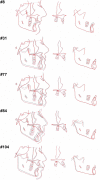Outcome assessment of orthodontic clear aligner vs fixed appliance treatment in adolescents with moderate to severe malocclusions
- PMID: 37407511
- PMCID: PMC10633795
- DOI: 10.2319/020923-94.1
Outcome assessment of orthodontic clear aligner vs fixed appliance treatment in adolescents with moderate to severe malocclusions
Abstract
Objective: To compare the efficacy and efficiency of treatment with clear aligners (CAT) vs fixed appliances (FAT) in adolescents with Class I and II moderate to severe malocclusions.
Materials and methods: One operator's (Garfinkle) cases from 2014 to 2019, started at age 12-18 years, with pre- and posttreatment records were identified and used according to an institutional review board-approved protocol. Records were measured by two calibrated, blinded investigators, aided by software (OrthoCAD [Cadent, Fairview, N.J.], Dolphin Imaging & Management Solutions [Chatsworth, Calif]). Discrepancy index (DI) and cast radiograph evaluation (CRE) scores, treatment duration, number of scheduled and emergency visits, and reported appliance and interarch elastic wear compliance were compared between groups using Wilcoxon rank sum and Fisher's exact tests. Cephalometric superimpositions were completed to evaluate craniofacial growth and dental changes.
Results: Records from 72 cases met the criteria and were included. For the 47 CAT and 25 FAT cases, mean DI (21 ± 5 and 24 ± 8, respectively; P = .20) and CRE (35 ± 10 and 34 ± 9, respectively; P = .90) scores were not significantly different. Other case attributes and reported appliance and interarch elastic wear compliance were also not significantly different. CAT vs FAT cases had significantly smaller treatment durations (24 ± 6 vs 27 ± 5 months; P = .01) and visit numbers (16 ± 5 vs 24 ± 4; P < .01), but emergency visit numbers were not significantly different (2 ± 2 vs 3 ± 2; P = .08).
Conclusions: In adolescents with Class I and II malocclusions and moderate to severe DI scores, on average, CAT vs FAT cases were completed 3 months faster with eight fewer visits, but treatment efficacy was not significantly different.
Keywords: Adolescent; Clear aligner; Fixed appliance; Malocclusion; Moderate; Severe.
© 2023 by The EH Angle Education and Research Foundation, Inc.
Figures




References
-
- Djeu G, Shelton C, Maganzini A. Outcome assessment of Invisalign and traditional orthodontic treatment compared with the American Board of Orthodontics objective grading system Am J Orthod Dentofacial Orthop 2005. 128292–298 discussion 298. - PubMed
-
- Boyd RL. Esthetic orthodontic treatment using the Invisalign appliance for moderate to complex malocclusions J Dent Educ 2008. 72946–967. - PubMed
-
- Robertson L, Kaur H, Fagundes NCF, Romanyk D, Major P, Flores Mir C. Effectiveness of clear aligner therapy for orthodontic treatment: a systematic review Orthod Craniofac Res 2020. 23133–142. - PubMed
MeSH terms
LinkOut - more resources
Full Text Sources
Miscellaneous

